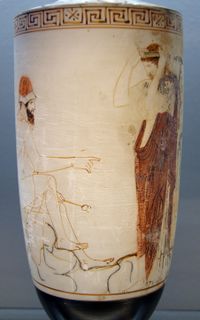العالم السفلي اليوناني

هرميس پسيخوپومپوس يجلس على صخرة، يستعد ليقود روح ميتة إلى العالم السفلي. Attic white-ground lekythos، ح. 450 ق.م.، Staatliche Antikensammlungen (Inv. 2797)
| العالم السفلي اليوناني |
|---|
| المقيمون |
| الجغرافيا |
| أشهر المساجين |
| الزوار |
العالم السفلي اليوناني، في الأساطير، هو عالم آخر تذهب إليه الأرواح بعد الموت، and is the original Greek idea of afterlife. At the moment of death the soul is separated from the corpse, taking on the shape of the former person, and is transported إلى مدخل العالم السفلي.[1] The Underworld itself is described as being either at the outer bounds of the ocean or beneath the depths or ends of the earth.[2] It is considered the dark counterpart to the brightness of Mount Olympus, and is the kingdom of the dead that corresponds to the kingdom of the gods.[3] Hades is a realm invisible to the living, made solely for the dead.[4]
الهامش
- ^ Long, J. Bruce (2005). Encyclopedia of Religion. Detroit: Macmillan Reference USA. p. 9452.
- ^ Garland, Robert (1985). The Greek Way of Death. London: Duckworth. p. 49.
- ^ Fairbanks, Arthur (1 January 1900). "The Chthonic Gods of Greek Religion". The American Journal of Philology. 21 (3): 242. doi:10.2307/287716. JSTOR 287716.
- ^ Albinus, Lars (2000). The House of Hades: studies in ancient Greek eschatology. Aarhus University Press: Aarhus. p. 67.
ببليوگرافيا
- Albinus, Lars (2000). The House of Hades: Studies in Ancient Greek Eschatology. Aarhus: Aarhus University Press.
- Buxton, R (2004). The complete World of Greek Mythology. London: Thames & Hudson Ltd.
- Camus, Albert. "The Myth of Sisyphus". Retrieved 3 December 2012.
- Fairbanks, Arthur (1900). "The Chthonic Gods of Greek Religion". The American Journal of Philology. The Johns Hopkins University Press. 21 (3): 241–259. doi:10.2307/287716. JSTOR 287716.
- Garland, Robert (1985). The Greek Way of Death. London: Duckworth.
- Leeming, David. "Demeter and Persephone". The Oxford Companion to World Mythology. Oxford University Press. Retrieved 2 December 2012.
- Leeming, David. "Styx". The Oxford Companion to World Mythology. Oxford University Press. Retrieved 2 December 2012.
- Long, J. Bruce (2005). "Underworld". Encyclopedia of Religion. Macmillan Reference USA. 14: 9451–9458.
- Mirtro, Marina Serena (2012). Death in the Greek world : from Homer to the classical age. Norman: University of Oklahoma Press.
- Mikalson, Jon D (2010). Ancient Greek Religion. West Sussex: Wiley-Blackwell.
- Mystakidou, Kyriaki; Tsilika, Eleni; Parpa, Efi; Katsouda, Elena; Vlahous, Lambros (2004–2005). "Death and Grief in the Greek Culture". Omega. Baywood Publishing Co. 50 (1): 23–34. doi:10.2190/yyau-r4mn-akkm-t496.
- O’Cleirigh, Padraig, Rex A Barrell, and John M Bell (2000). An introduction to Greek mythology : story, symbols, and culture. Lewiston: Edwin Mellen Press.
{{cite book}}: CS1 maint: multiple names: authors list (link) - Peck, Harry Thurston (1897). Harper's Dictionary of Classical Literature and Antiquities. Harper.
- Pfister, F (1961). Greek Gods and Heroes. London: Macgibbon & Kee.
- Scarfuto, Christine. "The Greek Underworld". Retrieved 3 December 2012.
- Schmiel, Robert (1987). "Achilles in Hades". Classical Philology. The University of Chicago Press. 82 (1): 35–37. doi:10.1086/367020. JSTOR 270025.
This article contains content from Wikimedia licensed under CC BY-SA 4.0. Please comply with the license terms.